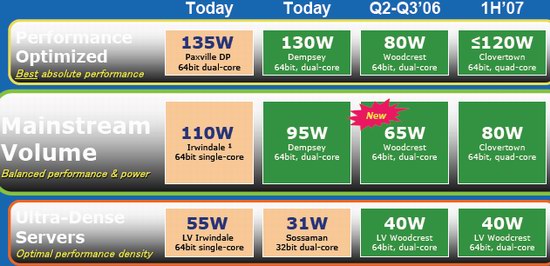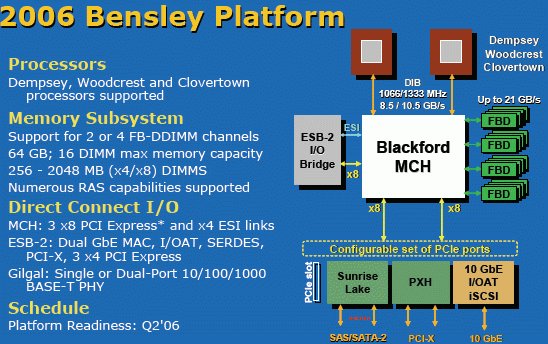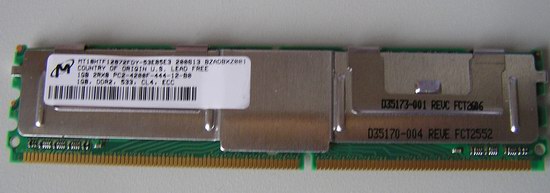Intel Woodcrest, AMD's Opteron and Sun's UltraSparc T1: Server CPU Shoot-out
by Johan De Gelas on June 7, 2006 12:00 PM EST- Posted in
- IT Computing
The New Intel Platform
The biggest advantage of Intel's newest Bensley platform is longevity: the Dempsey, Woodcrest and quad-core Clovertown Xeon all use the same socket and platform.

Bensley also eliminates the shared Xeon bus by giving each CPU an independent bus running at 1333 MHz. This is somewhat similar to the old Athlon MP platform, and it should be noted that this makes the Blackford Northbridge or MCH a pretty complex chip. Blackford also offers up to 4 memory channels and 24 PCI Express lanes.

The Dual Independent Bus (DIB) will not make much difference for Woodcrest and Dempsey as only some HPC applications are really limited by the FSB bandwidth. Three years of benchmarking tell us that most server and workstation application are not bottlenecked by the modern FSB speeds. The Opteron platform does not scale so much better thanks to NUMA in dual and quad core configurations. No, in most applications, the low latency integrated memory controller makes the difference, not FSB/NUMA bandwidth. Of course, with Clovertown, or two Woodcrests on one chip, a shared FSB might become a bottleneck, and in that case a DIB is a good idea.
The biggest innovation of Blackford is the introduction of fully buffered DIMMs (FB-DIMMs). On the FB-DIMM PCB we still find parallel DDR-2, but the Advanced Memory Buffer (AMB) converts this parallel data stream into a serial one to the Blackford chip. The serial links between the memory subsystem and the chipset not only eliminate skew problems but they also greatly simplify the routing on the motherboard. Routing quad-channel DDR-2 would be a nightmare.

The AMB, which you see under the heatsink in the middle of the DIMM, solves the skew and routing problems, and it comes with a relatively small price premium. The AMB also allows full duplex operation from the chipset to the AMB, where other memory bus designs are half duplex and introduce extra latency when alternating between send and receive modes. However, the AMB dissipates about 5 Watt and increases latency. This means that with 8 DIMMs or more, the advantage of using 65 Watt Woodcrest CPUs over 89-92 W Opterons will be gone.
The Blackford chipset uses X8 PCI Express links to talk to other various chips such as the ESB-2 I/O bridge, or "Southbridge" to keep it simple. The other PCI Express links can be used for 10 Gbit Ethernet or a SATA or SAS controller. A workstation version of Blackford, Greencreek will offer dual X16 PCI Express for running multiple workstation graphic cards.
The biggest advantage of Intel's newest Bensley platform is longevity: the Dempsey, Woodcrest and quad-core Clovertown Xeon all use the same socket and platform.

Bensley also eliminates the shared Xeon bus by giving each CPU an independent bus running at 1333 MHz. This is somewhat similar to the old Athlon MP platform, and it should be noted that this makes the Blackford Northbridge or MCH a pretty complex chip. Blackford also offers up to 4 memory channels and 24 PCI Express lanes.

The Dual Independent Bus (DIB) will not make much difference for Woodcrest and Dempsey as only some HPC applications are really limited by the FSB bandwidth. Three years of benchmarking tell us that most server and workstation application are not bottlenecked by the modern FSB speeds. The Opteron platform does not scale so much better thanks to NUMA in dual and quad core configurations. No, in most applications, the low latency integrated memory controller makes the difference, not FSB/NUMA bandwidth. Of course, with Clovertown, or two Woodcrests on one chip, a shared FSB might become a bottleneck, and in that case a DIB is a good idea.
The biggest innovation of Blackford is the introduction of fully buffered DIMMs (FB-DIMMs). On the FB-DIMM PCB we still find parallel DDR-2, but the Advanced Memory Buffer (AMB) converts this parallel data stream into a serial one to the Blackford chip. The serial links between the memory subsystem and the chipset not only eliminate skew problems but they also greatly simplify the routing on the motherboard. Routing quad-channel DDR-2 would be a nightmare.

The AMB, which you see under the heatsink in the middle of the DIMM, solves the skew and routing problems, and it comes with a relatively small price premium. The AMB also allows full duplex operation from the chipset to the AMB, where other memory bus designs are half duplex and introduce extra latency when alternating between send and receive modes. However, the AMB dissipates about 5 Watt and increases latency. This means that with 8 DIMMs or more, the advantage of using 65 Watt Woodcrest CPUs over 89-92 W Opterons will be gone.
The Blackford chipset uses X8 PCI Express links to talk to other various chips such as the ESB-2 I/O bridge, or "Southbridge" to keep it simple. The other PCI Express links can be used for 10 Gbit Ethernet or a SATA or SAS controller. A workstation version of Blackford, Greencreek will offer dual X16 PCI Express for running multiple workstation graphic cards.










91 Comments
View All Comments
zsdersw - Thursday, June 8, 2006 - link
I'm not saying the board is particularly stellar.. I'm saying that it's referred to by MSI as a "server" product.ashyanbhog - Thursday, June 8, 2006 - link
Irespective of what MSI says,fact is there were better mainstream boards for Anandtech to choose from if a honest, independent review was their intention
zsdersw - Thursday, June 8, 2006 - link
I.E., your comment belongs under someone else's.. not mine.zsdersw - Thursday, June 8, 2006 - link
And that's completely irrelevant to what I was saying.ashyanbhog - Thursday, June 8, 2006 - link
all I was saying is, its nice to see Intel finally making a comebackbut Anandtech seems have conducted a skewed benchmark that favours Intel, that unfairly increases the performance gap between Opteron and Woodcrest
In the final summary of the review he says
"In one word: Woodcrest rocks!"
There are quite a few holes in the review, the motherboard is just on of them,
I quoted MySQL number errors in my posts above,
just search for "ashyanbhog" in the page and read my earlier comments if you are interested.
AnandThenMan - Thursday, June 8, 2006 - link
What you're saying in general is irrelevant. Intel calls their integrated graphics "high performance" but that doesn't make it so.
MSI calling that a server board is just marketing, it does not represent what a true, high performance server class mobo is all about. Not that it's a bad piece of hardware, it is good for the price to be sure. But it is NOT a server class product.
zsdersw - Thursday, June 8, 2006 - link
At a certain price point, it could certainly be a nice entry-level server board.Performance alone isn't what makes a server-class motherboard a server-class motherboard.
ashyanbhog - Thursday, June 8, 2006 - link
One of the motherboards used in this review is a cheap piece that trades performance to keep price low.
Why was that motherboard selected over mainstream server/workstation boards that are proven to offer slightly better performance? Why pick a 250$ MSI board for opteron over $500 boards from Tyan, Iwill, Supermicro or others. The Intel Xeon "Inderwale" gets a $500 board, so price could not have been the issue.
So what's the point in using a Single Channel board for this benchmark, when price was not a limitation?
Single memory channel boards like the one from MSI, are known to offer lower performance than dual / dedicated memory channel boards when used in 2P Opteron configurations. Dual Channel boards are the mainstream boards for 2P Opteron systems. There are plently Server boards available in Dual / dedicated memory lane configuration. There are enough reviews on the net to show the performance diff b/w single memory channel boards and dual memory channel boards
The issue is not about the MSI or its class, the issue is why did Anandtech pick a Single memeory channel board instead of a more mainstream dual memory channel board.
Hope that clears up "zsdersw"'s query
zsdersw - Thursday, June 8, 2006 - link
I'm not making excuses for the choices that were made regarding this comparison test. I'm talking about what constitutes a "server-class" motherboard.ashyanbhog - Thursday, June 8, 2006 - link
Game PC review link for the above commenthttp://www.gamepc.com/labs/view_content.asp?id=tig...">http://www.gamepc.com/labs/view_content.asp?id=tig...